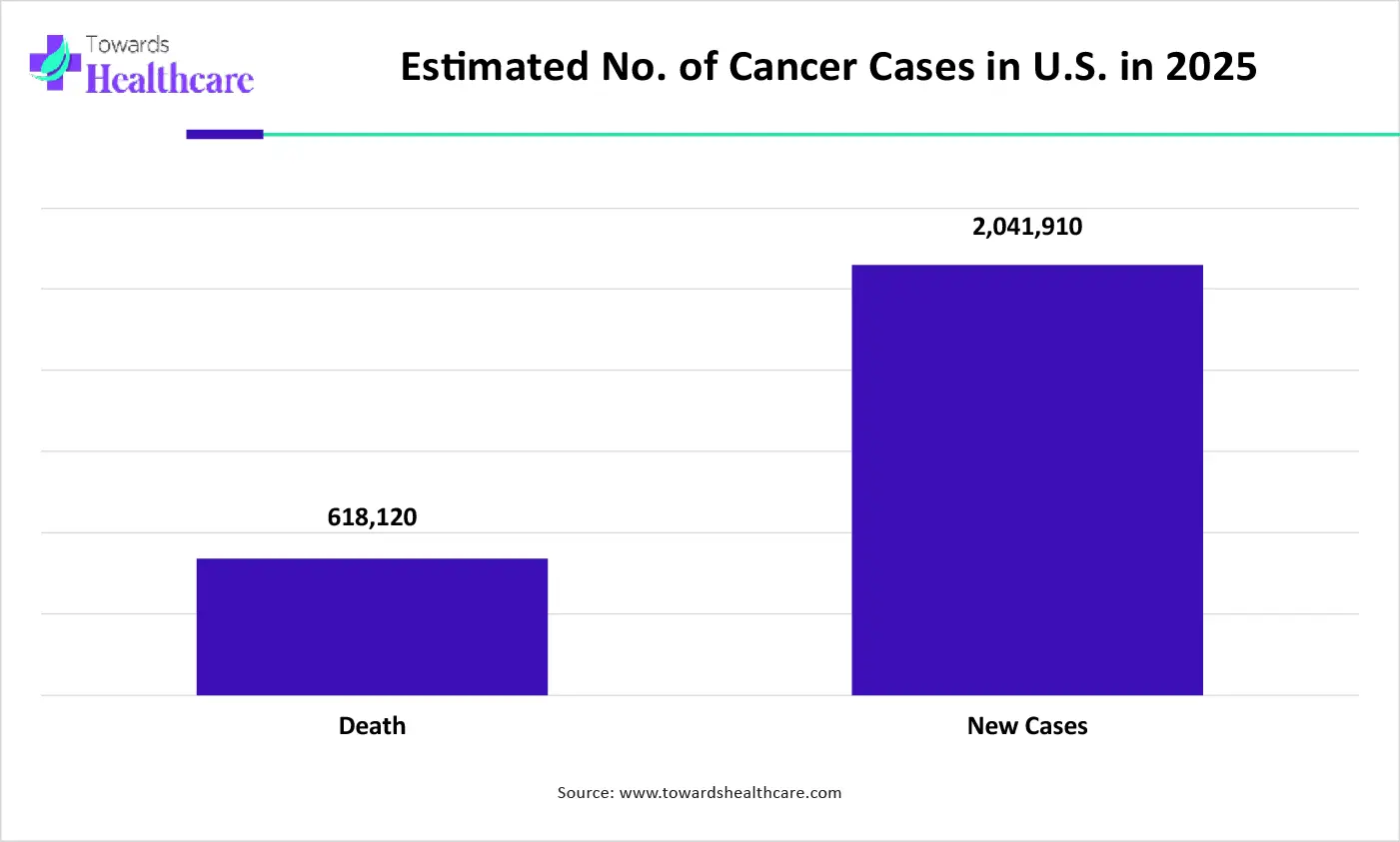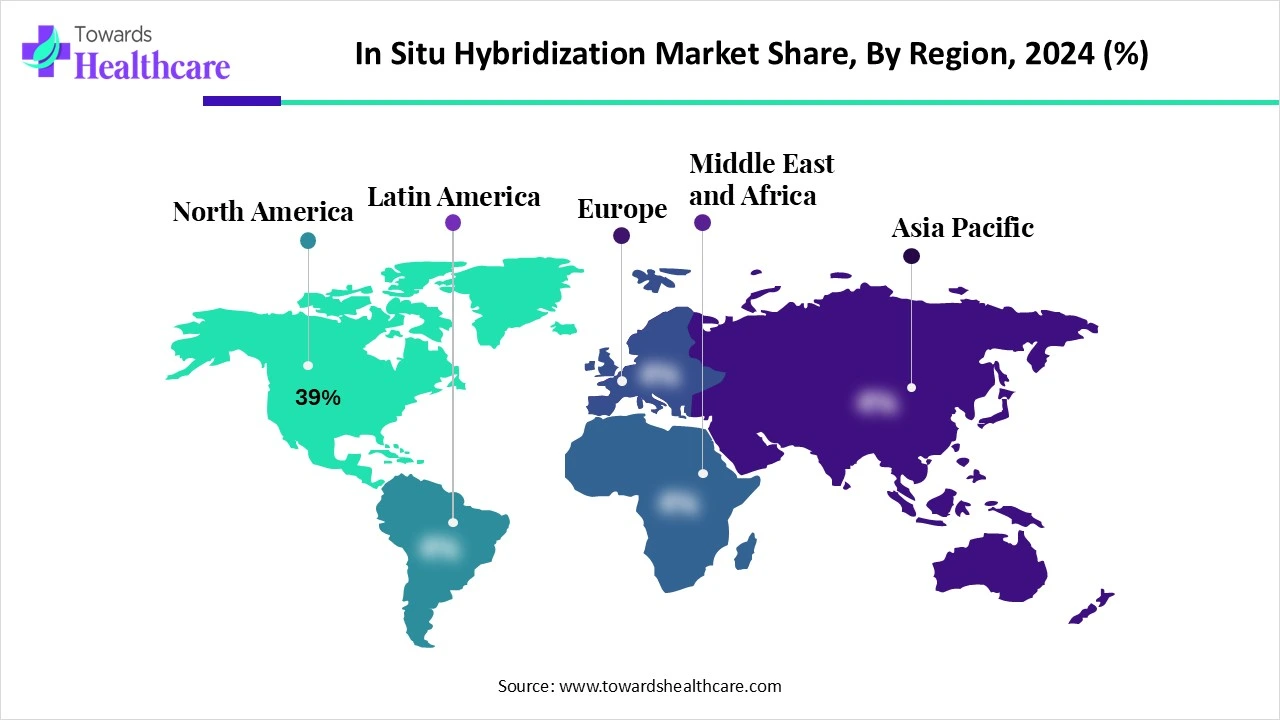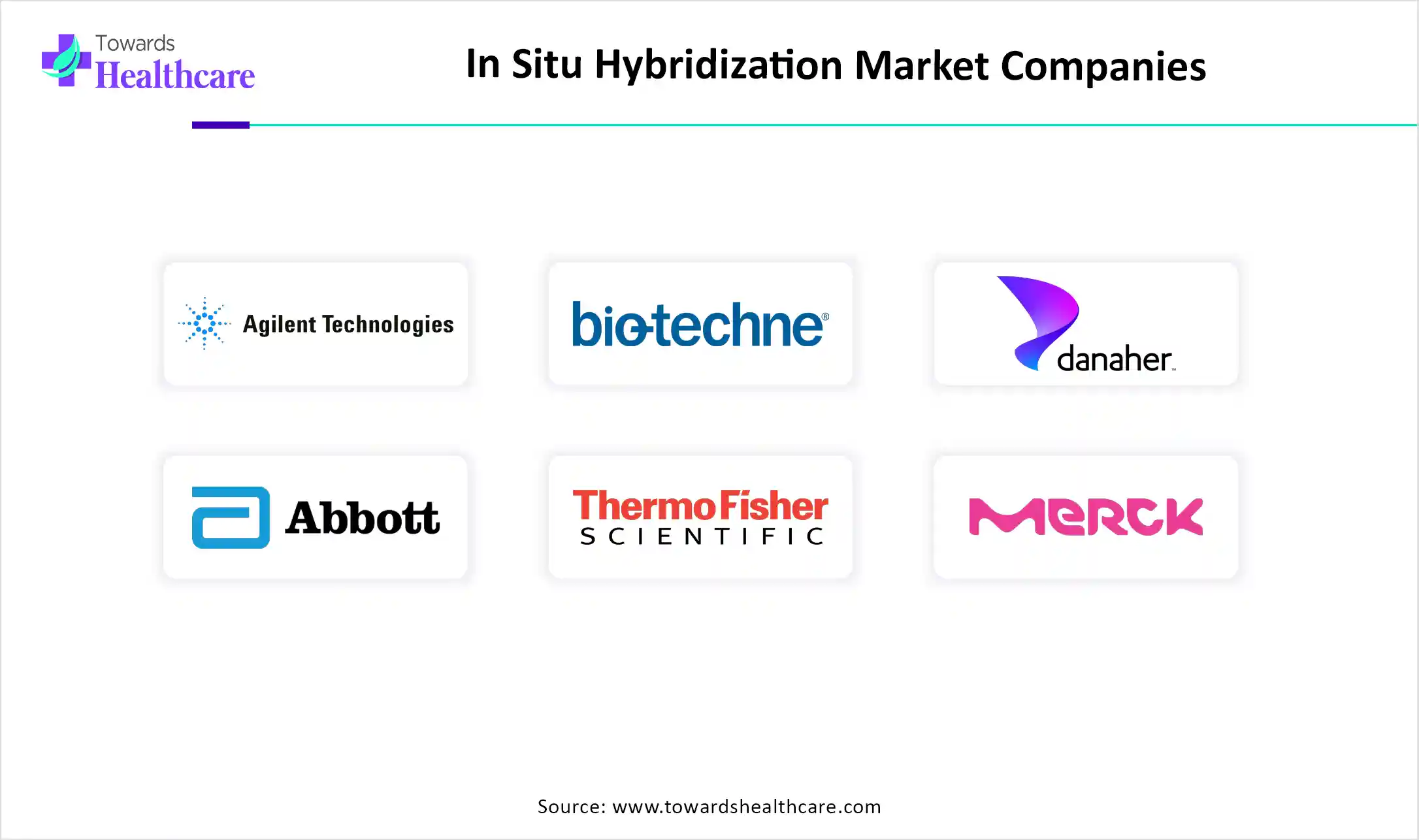January 2026

The global in situ hybridization market size touched US$ 1.55 billion in 2024, with expectations of climbing to US$ 1.66 billion in 2025 and hitting US$ 3.14 billion by 2034, driven by a CAGR of 7.33% over the forecast period.

The use of in situ hybridization is increasing for the detection of various diseases and for the development of targeted treatment approaches. Their use in the development of molecular diagnostics, personalized treatment approaches, and drug discoveries is increasing. AI is also being integrated with it to improve its workflow and accuracy. These advancements are leading to new collaborations among different companies. Similarly, to tackle the growing diseases, their use in different regions is increasing, which is supported by the government. This is promoting the market growth.
| Metric | Details |
| Market Size in 2025 | USD 1.66 Billion |
| Projected Market Size in 2034 | USD 3.14 Billion |
| CAGR (2025 - 2034) | 7.33% |
| Leading Region | North America Share 39% |
| Market Segmentation | By Technology, By Product, By Application, By End User, By Region |
| Top Key Players | Agilent Technologies, Bio-Techne Corporation, Danaher Corporation, Abbott Laboratories, Thermo Fisher Scientific, Merck KGaA, PerkinElmer Inc., Biocare Medical LLC, Genemed Biotechnologies, Enzo Life Sciences Inc., BioGenex Laboratories, Abnova Corporation BioVision Inc., Zytomed Systems GmbH, Advanced Cell Diagnostics, NeoGenomics Laboratories, OriGene Technologies, Roche Diagnostics, Genomic Vision, Exiqon A/S |
In Situ Hybridization (ISH) is a molecular technique used to detect specific nucleic acid sequences (DNA or RNA) directly within fixed tissues and cells, allowing for spatial localization of gene expression or chromosomal abnormalities. The method employs labeled probes that hybridize with target sequences, which are then visualized through chromogenic (CISH) or fluorescent (FISH) detection systems. ISH is widely used in diagnostics (especially cancer and genetic disorder identification), neuroscience, infectious disease detection, and pharmaceutical research, offering high specificity, spatial context, and molecular insight.
The use of AI in in situ hybridization is increasing for various purposes. The complex images generated for ISH are effectively analyzed and interpreted by using AI. This helps in minimizing human errors and variability. It also helps in optimizing the steps involved in ISH, which helps to reduce the time and manual labor. Furthermore, AI models are being developed that can enhance multimodal analysis along with remote diagnostics. Thus, by integrating AI in in situ hybridization, the R&D and drug discoveries can be accelerated.
Increasing Drug Discoveries
The use of in situ hybridization is increasing in the drug discovery process as it helps in the identification of drug targets. This, in turn, helps to minimize the drug side effects and ensures its safety. Similarly, in the development of personalized medicines, it can help to discover the biomarkers, making the drug show site-specificity. At the same time, it also helps in monitoring the effect of the drug on gene expression as well as its toxicity. Thus, this promotes the in situ hybridization market growth.
Time-Consuming Procedures
In situ hybridization consists of various steps that require skilled personnel and are time-consuming. This limits their use in large-scale research. Additionally, the diagnostic results obtained from in situ hybridization require a time period of 1 or 2 days. This makes the clinicians shift to the use of faster diagnostic tools. Thus, this may restrain the use of in situ hybridization.
Growing Demand for Diagnostic Approaches
The growing diseases and awareness are increasing the demand for the use of precise diagnostic options. This is increasing the use of in situ hybridization as it helps in the visualization of specific DNA or RNA sequences within the tissues. It is also being used in the development of molecular diagnostics as it can detect pathogen genomes. Moreover, as it provides nucleic acid level insights, it is also being used in the development of histopathology testing and biopsy-based diagnosis. Thus, all these developments are promoting the in situ hybridization market growth.
For instance,
By technology type, the fluorescence in situ hybridization (FISH) segment led the market with approximately 72% share in 2024 and is expected to sustain the position during the forthcoming years. It showed high specificity and sensitivity, enhancing the accuracy. It helped in the detection of multiple targets. Thus, this enhanced the market growth.
In the fluorescence in situ hybridization (FISH) segment, the RNA FISH sub-segment is expected to show the highest growth during the predicted time. It is being used in cancer and neuroscience research. It is also used for the detection of RNA-based biomarkers. It also helps in the spatial mapping of mRNA.
By product type, the probes segment held the dominating share of approximately 34% in the market in 2024. It was an important component of FISH, which increased their use. It was crucial for the detection of DNA or RNA sequences. This increased their use for infectious disease diagnosis as well as genetic testing.
By product type, the reagents & kits segment is expected to show the fastest growth rate during the predicted time. This helps in ensuring the reproducibility and provides consistent results. This, in turn, is increasing their use in clinical diagnostics. Moreover, their demand is also increasing due to growing research and development.
By application type, the cancer diagnostics segment led the market with approximately a 45% share in 2024. There was a rise in the cancer cases. This, in turn, increased the development of various diagnostic and therapeutic approaches while increasing the use of ISH. Thus, this promoted the market growth.

The graph represents the estimated number of cancer cases in the U.S. in the year of 2025. It indicates that there will be a rise in the new cases of cancer. Hence, it increases the demand for in situ hybridization for the development of new cancer diagnostics. Thus, this in turn will ultimately promote the market growth.
By application type, the infectious disease diagnosis segment is expected to show the highest growth during the upcoming years. The incidence of infectious diseases is increasing. This is growing the adoption of ISH for accurately detecting the pathogen DNA or RNA from the biological samples. They are also supporting the development of personalized treatment plans.
By end user, the hospitals & diagnostic laboratories segment held the largest share of approximately 40% in the global market in 2024. They use ISH for the diagnosis of various diseases. Moreover, the presence of advanced infrastructure promoted their use. Additionally, the reimbursement policies encouraged the use of advanced ISH platforms.
By end user, the pharmaceutical & biotechnology companies segment is expected to have the fastest growth rate during the upcoming years. The growing research and development are increasing the use of ISH. Similarly, the increasing drug discoveries are also increasing their utilization. These are leading to new collaborations supported by various investments.

North America dominated the in situ hybridization market share by 39% in 2024. North America consisted of a well-developed healthcare sector. This increased the use of in situ hybridization for diagnostic purposes. This contributed to the market growth.
The industries in the U.S. are focusing on improving the workflow of in situ hybridization to deal with the growing cancer cases. This, in turn, is increasing the investments from various sources. At the same time, advanced technologies are being integrated with it to enhance its accuracy and image analysis.
The growing research and development in the industries, as well as the institutes of Canada, are increasing the use of in situ hybridization. These developments are being supported by the NIH funding. This, in turn, is accelerating their development and clinical trials as well.
Asia Pacific is expected to host the fastest-growing in situ hybridization market during the forecast period. The growing diseases in the Asia Pacific are increasing the demand for the use of early and accurate diagnostic tools as well as new treatment options. This is increasing the use of ISH. This is enhancing the market growth.
The increasing incidence of diseases such as infectious and genetic diseases in China is increasing the use of ISH. Similarly, they are also being used in the development of cancer diagnostic approaches. Moreover, the policies and initiatives from the government are supporting their development, use, and approvals.
The use of ISH in India is increasing due to growing research and development to tackle the increasing diseases. At the same time, the expanding healthcare sector is increasing its adoption rates. Moreover, they are also widely used in molecular assays and in the development of targeted therapies.
Europe is expected to grow significantly in the in situ hybridization market during the forecast period. The increasing incidence of cancer and genetic disorders in Europe is increasing the demand for ISH. These are being used in the development of diagnostic tools. This is promoting the market growth.
The industries in Germany are developing advanced ISH platforms, which, in turn, are leading to new collaboration among them. At the same time, they are integrating AI to improve its accuracy and efficiency. This is increasing their research and development as well as clinical trials. These are further supported by the government.
The increasing cancer burden in the UK is increasing the utilization of ISH. Moreover, the presence of the advanced healthcare sector is increasing its use for diagnostic as well as drug development purposes. Furthermore, the initiatives and investments provided by the government and regulatory bodies are encouraging their use.

In January 2025, to integrate RNA-ISH using the BOND RX and BOND RXm research staining systems, a collaboration between Lecia Biosystem and Molecular Instruments, Inc.® (MI) was announced, where the Chief Commercial Officer at Molecular Instruments, Dr. Aneesh Acharya, stated that, they are pleased with this collaboration and will be providing the next-gen workflows HCR™ Pro for BOND RX and RXm users. With the Leica Biosystems team, they will support the transition from legacy technologies to HCR™ Pro RNA-ISH and accelerate its pace, for the user who have already adopted HCR™ Pro kits on their instruments.
By Technology
By Product
By Application
By End User
By Region
According to market projections, the vegetarian softgel capsules sector is expected to grow from USD 996.32 mi...
January 2026
January 2026
December 2025
December 2025